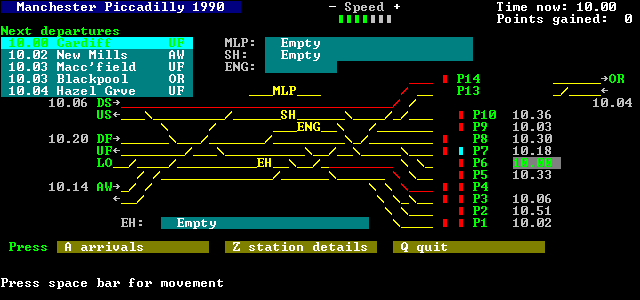|
This is now one of the busiest stations in the country, with an intensive local service as well as through trains to most parts of the country. The through platforms 13 and 14 are particularly busy, with trains every few minutes including the Trans-Pennine services now diverted through Piccadilly. Most types of present-day passenger motive power appear, including units of classes 101, 108, 142, 150, 155, 156 and 304, as well as diesel and electric locomotives. Includes 1991 version, with class 158 on Trans-Pennine services!
|
|
This simulation is set at Piccadilly Station in Manchester. Piccadilly is a combined through station and terminus of the former LMS, previously LNWR, main line from Stockport, Crewe and London Euston; other routes go to Liverpool in the west, Bolton and Preston for the north, and to Stalybridge, Sheffield and the east. There are also suburban lines to Altricham, Buxton, New Mills Central and Rose Hill (Marple), and a loop (the Styal Line) which bypasses Stockport and rejoins the Crewe line at Wilmslow.
There is generally an hour service to London Euston, now operated in push-pull mode by classes 86/2, 87 and 90 with Driving Van Trailers (DVTs) in the 821xx number series; the locomotive is always at the Manchester end. There is also an hourly service to Birmingham, usually operated by the same classes as above, though some workings are covered by long-range diesel locomotives of class 47/8. Some Birmingham services work through to destinations in the south and south-west such as Poole and Paignton, though engines are usually changed at Birmingham or Coventry; some also continue northwards as far as Edinburgh or Glasgow. One of the strange consequences of the link-up of the southern and northern halves of the Inter-City network at Birmingham has been the introduction of through trains from Paddington to places such as Manchester and Edinburgh; who would have dreamed a few years ago of being able to travel from Paddington to Glasgow via Birmingham and Manchester?
Over the past few years traffic in Manchester has been concentrated on Piccadilly and Victoria stations, and in the last few years Piccadilly has seen several new services. Most recently the Trans-Pennine services from Liverpool to Newcastle have been diverted from Victoria, and now travel via Oxford Road and Piccadilly before rejoining their traditional route at Stalybridge. Until early 1991 these services were loco-hauled, usually by class 47, but Express units of class 158 have now taken over.
The Provincial Sector (now Regional Railways) has also instituted a number of new long-distance Express services, and Piccadilly is served by those from Liverpool to Norwich and other stations in East Anglia, as well as occasional summer extras from Nottingham to Preston and Blackpool. The main Trans-Pennine service is supplemented by Express services from Piccadilly to Scarborough and Hull. Most of the services in this group are operated by class 156 units. In addition, there is an hourly service between Cardiff and Manchester Piccadilly via Hereford, Shrewsbury and Crewe, operated by class 155 units at present.
Local services are operated throughout the area is conjunction with Greater Manchester PTE. On the electrified lines to Hadfield, Altricham, Alderley Edge and Crewe services are worked by the elderly units of class 304, which date from 1960 and are due for replacement within a year or two. Services via Ardwick to Rose Hill, New Mills Central and Sheffield, and also to Chester via Stockport, are generally still provided by first generation diesel multiple units of classes 101 and 108, though the occasional service may see a class 142 Pacer or class 150 Sprinter. The Buxton service is now normally the exclusive preserve of class 150/2 Sprinters based at Newton Heath. Longer-distance services include regular class 142 workings from Cheadle Hulme and Hazel Grove, both just beyond Stockport, to Wigan and Southport, while the service from Stockport to Blackpool North is worked by Sprinters of classes 150/1 and 150/2
The station is seen on a busy Saturday in the summer of 1990, or on a weekday in the spring of 1991, depending on your choice. You have to direct all the trains in and out, selecting platforms to avoid delays and minimise congestion; you also have to allocate motive power to each loco-hauled service. You will have to plan how to use the available platforms to avoid conflicts between arrivals and departures, and adjustments will be needed when arrivals are running late.
|
